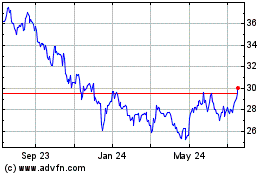By Jenny Strasburg, Drew Hinshaw and Bojan Pancevski
LONDON -- Britain's first-in-the-West authorization of a
Covid-19 vaccine thrusts its little-known medicines watchdog into
the global spotlight -- weeks before the U.K.'s split from the
European Union adds to the regulator's responsibilities.
The Medicines and Healthcare Products Regulatory Agency signed
off Wednesday on a vaccine developed by Pfizer Inc. and Germany's
BioNTech SE, setting in motion its rollout in the U.K. It reached a
decision ahead of higher-profile watchdogs, such as the U.S. Food
and Drug Administration and the European Medicines Agency.
It is the British agency's highest-profile move ahead of the
Dec. 31 end to the U.K.'s transition out of the EU. After that
date, the MHRA will be the regulator with the primary
responsibility for drugs authorized for use in the U.K., stepping
out of the shadow of the EMA, which had that role for the last 16
years.
"The MHRA has enormous incentive to appear very smooth to ensure
that starting in 2021, companies will come to them with new drugs,
new vaccines," said Stephen Evans, professor of
pharmacoepidemiology at the London School of Hygiene & Tropical
Medicine. It is a dress rehearsal with the whole world watching, he
said, and the message is: "We'll do it quickly."
June Raine, head of the MHRA, said in a televised briefing on
Wednesday that the agency followed international vaccine-review
standards, from deciding hurdles for safety and effectiveness in
the summer to monitoring the quality of Pfizer-BioNTech doses
coming out of factories in recent days. Asked about any concerns
that the regulator had rushed the process, Dr. Raine said,
"Everyone can be absolutely confident that no corners whatsoever
have been cut."
The FDA and the EMA have defended their slower approach. Both
agencies have rapidly compressed their own typical vaccine-approval
timelines, and both are expected to make a decision on the Pfizer
vaccine this month.
The FDA on Dec. 10 will hold an online public meeting, with
expert advisers, to discuss emergency-use authorization of the
vaccine. Scientists and other members of the public can submit
comments beforehand. The next day, the EMA will host a virtual
public meeting to talk about vaccine development and regulatory
reviews.
Such meetings -- designed to bolster confidence in the
regulatory process -- require extensive time and planning.
Researchers say they might help address people's hesitancy to take
vaccines. The FDA is expected to make a decision on the Pfizer shot
a few days after the Dec. 10 meeting. FDA Commissioner Stephen Hahn
told ABC News on Tuesday that the agency would take the time
necessary to perform its own analysis.
The FDA scheduled the public meeting on Nov. 20, in part to
assure the public it wasn't being rushed by political
considerations. It is expected to rule on a vaccine from Moderna
Inc. a short time after it makes a call on the Pfizer shot.
The EMA said Wednesday that it was pursuing a broader category
of authorization, which would be more sweeping and permanent than
the British decision. EU law doesn't allow the EMA to reach the
kind of temporary, emergency-use authorization that the U.K.
pursued, agency officials said. As such they needed more evidence
and assurances that manufacturing controls will remain in place
after authorization, they said.
"These are essential elements to ensure a high level of
protection to citizens during the course of a mass vaccination
campaign," an EMA spokeswoman said.
The EMA is set to announce a decision about Pfizer's vaccine by
Dec. 29 and Moderna's vaccine by Jan. 12. In each case, the agency
will have to convene its high-level scientific committee for human
medicines before reaching a judgment. Communication between
drugmakers and the EMA has been slowed by data-formatting issues
and software compatibility, according to people familiar with the
matter. Last week, the agency said it was willing to consider ways
to speed up its system, and asked pharmaceutical companies to make
suggestions.
The U.K. agency has the advantage of having been a workhorse of
the EMA during the country's time in the EU, handling evaluations
for a large chunk of the overall bloc's new medicines. Individual
EU countries oversee clinical trials; the EMA enforces guidelines
for safety, effectiveness and quality, and coordinates bloc-wide
decisions, via committee, on authorized use.
The U.K.'s decision to leave the EU pushed the EMA last year to
move out of its London headquarters and set up shop in
Amsterdam.
The EMA by then had already been doling out the U.K. regulator's
massive portfolio of Europe-wide medicine evaluations to other EU
countries. The 370 medicines at the time that were part of the
U.K.'s responsibility were redistributed among 27 EU nations plus
Iceland and Norway, the EMA has said.
With its workload lessened, the MHRA "has been relatively
underworked," said Prof. Evans. That has given it additional
bandwidth to act quickly, researchers said. The London-based MHRA
also gained experienced staff who left the EMA and stayed behind in
the city.
British regulators and ministers also no longer need to go
through the EU committee system. "There is an advantage in being
small," said George Freeman, a former U.K. life-sciences minister
who oversaw MHRA changes to speed up drug reviews.
The agency -- not a household name even in its home country --
was founded in 2003 with the merger of separate U.K. regulators for
medicines and medical devices, and has a staff of 1,320. The EMA
has about 900 employees, though it doesn't evaluate medical devices
or oversee clinical trials. The FDA has a staff of around
17,000.
For the vaccine green light, the U.K. government used a
long-held power to authorize drugs on its own in an emergency,
allowing the MHRA to review the drug outside the EMA framework even
before the end of the Brexit transition period. All other EU
members have the same power, but none have publicly declared plans
to exercise it.
Pfizer executive Ralf Rene Reinert said during a media briefing
on Wednesday he was receiving emails about other countries
considering pursuing more-rapid authorization, following the U.K.'s
lead. "The world is at the moment looking at the U.K.," he said. He
didn't name the countries.
Like the FDA and the EMA, the British agency used data from
large-scale human trials handed over in rolling batches as the
trials progressed. People who have been working with the MHRA in
recent months say it has been more proactive in working with drug
companies as they provide data, asking additional questions and
requesting more information that could speed a review.
Recently, the MHRA's "rolling review is a much more interactive
experience," said Sarah Blagden, associate professor of
experimental cancer therapeutics at the University of Oxford, who
oversees cancer trials. "The regulators become part of the
discussion very, very early on."
In the run-up to the Pfizer vaccine authorization in the U.K.,
teams from the company and its partner BioNTech worked around the
clock with counterparts at the MHRA, answering individual queries
and providing extra, bespoke data when necessary, according to
people familiar with the process. They said the MHRA was sending
questions to the companies through last weekend.
Prof. Reinert, the Pfizer executive, said the MHRA would respond
quickly, sometimes after just 10 minutes, to data it sent in.
BioNTech praised the U.K. regulator. "The MHRA has asked the
same level of detail of questions as any agency," said Sean Marett,
BioNTech's chief business and commercial officer.
The U.K. government has also asked the agency to review a
vaccine being co-developed by AstraZeneca PLC and the University of
Oxford ahead of a possible emergency-use authorization. The U.K.
has said it is doing rolling reviews of trial data from the shot by
Moderna, too, and that the vaccine, if authorized, could be
available in the U.K. as early as the spring, similar to the rest
of Europe.
Write to Jenny Strasburg at jenny.strasburg@wsj.com, Drew
Hinshaw at drew.hinshaw@wsj.com and Bojan Pancevski at
bojan.pancevski@wsj.com
(END) Dow Jones Newswires
December 02, 2020 11:04 ET (16:04 GMT)
Copyright (c) 2020 Dow Jones & Company, Inc.
Pfizer (NYSE:PFE)
Historical Stock Chart
From Mar 2024 to Apr 2024

Pfizer (NYSE:PFE)
Historical Stock Chart
From Apr 2023 to Apr 2024
